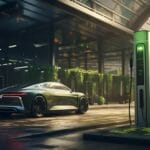The global shift toward electric vehicles (EVs) is not just reshaping transportation but also the infrastructure supporting it. Petrol pumps, long-standing pillars of the traditional automotive fuel industry, face a new reality: the rise of EVs is steadily reducing demand for fossil fuels. However, this challenge presents an opportunity. Petrol stations can evolve into EV charging hubs, serving the growing EV user base and positioning themselves as integral parts of the e-mobility ecosystem.
This blog explores the steps petrol pumps can take to transition into EV charging hubs, the benefits of doing so, and how they can overcome challenges in this transformation.
Why Transition to EV Charging?
1. Declining Fossil Fuel Demand
Global EV adoption is rising rapidly. Governments and automakers are committing to phasing out internal combustion engine (ICE) vehicles over the next two decades. As a result, traditional fuel demand is projected to decline significantly.
2. Growing EV Market
- Global Trends: The EV market is expected to grow at a compound annual growth rate (CAGR) of 25% over the next decade.
- Government Incentives: Many countries offer subsidies and tax breaks for EV infrastructure, making it financially viable for petrol pumps to diversify.
3. New Revenue Streams
By adding EV charging stations, petrol pumps can tap into a new and growing market while diversifying their revenue streams beyond fossil fuels.
Steps to Transition to EV Charging Hubs
Step 1: Assess Demand and Location Feasibility
- Understand EV Density: Evaluate the number of EVs in the surrounding area and their growth projections.
- Analyze Traffic Patterns: Locations with high vehicle traffic or proximity to urban centers, highways, or commercial areas are ideal for EV hubs.
Step 2: Choose the Right Charging Infrastructure
- AC Chargers: Suitable for locations with long dwell times, such as stations near residential areas or workplaces.
- DC Fast Chargers: Ideal for high-traffic petrol pumps where users require quick charging.
- Ultra-Fast Chargers: Cater to highways or transit hubs where minimal downtime is critical.
Step 3: Partner with EV Charging Providers
Collaborate with established charging solution providers to:
- Source hardware that complies with standards like OCPP (Open Charge Point Protocol).
- Implement charging management software to monitor, control, and optimize station operations.
- Offer seamless payment options such as RFID, mobile apps, and digital wallets.
Step 4: Integrate Renewable Energy Solutions
Incorporate solar panels or wind energy to power chargers sustainably and reduce operational costs. Excess energy can be stored in batteries for peak usage.
Step 5: Upgrade Power Infrastructure
High-capacity EV chargers require substantial power. Partner with utility companies to ensure your grid connection is adequate. Smart energy management systems can balance power loads efficiently.
Step 6: Enhance Customer Experience
- Amenities: Provide EV drivers with cafes, Wi-Fi, or retail options while they wait.
- Digital Solutions: Offer mobile apps for real-time station availability, booking, and payment.
Benefits of Transitioning to EV Charging Hubs

1. Future-Proofing the Business
By adapting to the shift in fuel demand, petrol pumps ensure they remain relevant as EV adoption grows.
2. Increased Foot Traffic
EV charging hubs attract new customers, many of whom spend time and money on additional services while charging their vehicles.
3. Diverse Revenue Streams
Charging fees, partnerships with EV manufacturers, and income from ancillary services like cafes or retail stores create multiple income sources.
4. Enhanced Sustainability Credentials
Transitioning to EV charging aligns with global sustainability goals and enhances a station’s reputation as an environmentally conscious business.
Overcoming Challenges
1. High Initial Investment
- Solution: Leverage government grants, subsidies, or financing options to offset installation costs.
- Long-Term ROI: Emphasize the growing EV market and the potential for significant returns over time.
2. Power Supply Limitations
- Solution: Work with utility providers to upgrade power capacity and use load management systems to optimize energy usage.
3. Space Constraints
- Solution: Optimize layouts to integrate chargers into existing spaces without disrupting traditional fuel services.
4. Customer Awareness
- Solution: Educate customers about EV charging options through marketing campaigns and on-site staff training.
Case Studies: Successful Transitions
1. Shell’s EV Charging Expansion
Shell, a global oil and gas leader, is integrating EV chargers across its petrol stations in key markets, aiming for a significant share of the EV charging market by 2030.
2. BP Pulse’s Charging Hubs
BP Pulse has established ultra-fast charging hubs at petrol stations, targeting high-traffic areas to cater to EV users needing quick recharges.
3. Indian Petrol Pumps Adding EV Chargers
In India, petrol stations are partnering with government initiatives and private charging solution providers to offer EV charging, meeting the country’s rapid EV growth.
EV Charging Hub Models for Petrol Pumps
1. Hybrid Model
- Continue offering traditional fuel services alongside EV charging.
- Best for locations with a mix of ICE vehicles and EVs.
2. Dedicated EV Hub
- Focus solely on EV charging infrastructure.
- Ideal for urban areas or places with high EV density.
3. Public-Private Partnerships
- Collaborate with governments or private entities to co-develop EV hubs.
- Leverage shared investment and operational expertise.
EV Charging Software: A Key Enabler
Charging software is crucial for efficiently managing EV hubs:
- Real-Time Monitoring: Track charger availability and usage.
- Dynamic Pricing: Adjust rates based on demand or time of day.
- Seamless Payments: Offer multiple payment options, including mobile wallets and RFID.
- Energy Optimization: Use smart systems to manage power loads and reduce costs.
The Role of Governments in Supporting Transitions
Governments worldwide are encouraging petrol stations to add EV chargers by:
- Offering financial incentives, such as grants and subsidies.
- Mandating a minimum number of EV chargers in new or existing stations.
- Creating policies to streamline installation processes.
The Future of EV Charging Hubs
1. Wireless Charging
Inductive charging technology eliminates the need for cables, providing a seamless experience for EV users.
2. Battery Swapping
Instead of charging on-site, stations could offer pre-charged battery swapping for faster turnaround times.
3. Vehicle-to-Grid (V2G) Solutions
Petrol pumps could serve as energy hubs, allowing EVs to return power to the grid during peak demand.
4. Integration with Smart Cities
EV charging hubs will play a key role in smart city ecosystems, integrating with public transit, renewable energy, and digital platforms.
Conclusion
The rise of EVs is reshaping the automotive landscape, and petrol pumps have a unique opportunity to remain relevant by transitioning into EV charging hubs. By adopting the right infrastructure, leveraging partnerships, and enhancing the customer experience, petrol stations can position themselves as central players in the e-mobility revolution.
As the EV market continues to grow, the question for petrol pumps is not whether to adapt but how soon they can make the shift. Those who act now will gain a competitive edge, future-proof their businesses, and contribute to a greener, more sustainable future.
Ready to transition? Partner with EVYA to create cutting-edge EV charging hubs and drive the future of mobility.





3 Comments
Lorem ipsum dolor sit amet, consectetur adipiscing elit, sed do eiusmod tempor incididunt ut labore et dolore magna aliqua. Quis ipsum suspendisse ultrices gravida. Risus commodo viverra maecenas accumsan lacus vel facilisis.
Cras maximus ultricies volutpat. Praesent ut enim non enim vulputate fringilla.
Cras maximus ultricies volutpat. Praesent ut enim non enim vulputate fringilla.